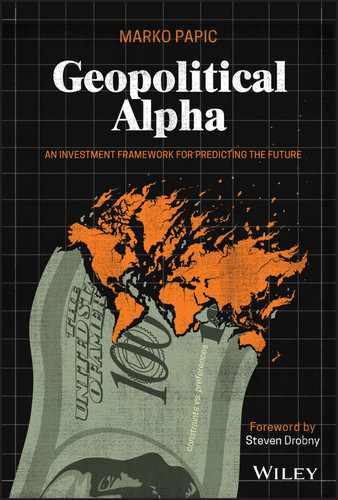Forecast geopolitics and markets with this clear and insightful resource Geopolitical Alpha – An Investment Framework for Predicting the Future provides readers with an original and compelling approach to forecasting the future and beating the markets while doing so. Persuasively written by author, investment strategist, and geopolitical analyst Marko Papic, the book applies a novel framework for making sense of the cacophony of geopolitical risks with the eye towards generating investment-relevant insights. Geopolitical Alpha posits that investors should ignore the media-hyped narratives, insights from "smoke-filled rooms," and most of their political consultants and, instead, focus exclusively on the measurable, material constraints facing policymakers. In the tug-of-war between policymaker preferences and their constraints, the latter always win out in the end. Papic uses a wealth of examples from the past decade to illustrate how one can use his constraint-framework to generate Geopolitical Alpha. In the process, the book discusses: Perfect for investors, C-suite executives, and investment professionals, Geopolitical Alpha belongs on the shelf of anyone interested in the intersection of geopolitics, economics, and finance.
Table of Contents
- Cover
- Foreword
- Introduction
- Part One: SCAFFOLDING
- Chapter 1: We're Not in Kansas Anymore
- Cut off from the Yellow Brick Road
- The End of the Goldilocks Era
- The Tornado Hits Kansas: Geopolitical Paradigm Shifts
- The Nail in the Coffin: COVID-19
- Welcome to Oz
- Beware of the Wizards
- Notes
- Chapter 2: The Constraint Framework: Three Pillars
- Geopolitics Is Not a “Nice-to-have”
- The First Pillar: Materialist Dialectic
- Second Pillar: Diagnosticity of Constraints
- Diagnosticity in Practice
- Third Pillar: The Person versus the Situation
- Fundamental Attribution Error in Practice
- The Three Pillars of the Constraint Framework
- And Now for Some Math
- Where Do We Go from Here?
- Notes
- Chapter 3: The Wizards of Oz
- Overview: Intelligence and Investing
- The False Expert
- The Connected Player
- The Funnel
- The Insider
- The Spy
- You Cannot Outsource Your Fiduciary Duty
- Notes
- Part Two: THE CONSTRAINTS
- Chapter 4: Politics
- “You May Have All the Money, Raymond …”
- … But Boris Has All the Rhetoric
- Introducing the Median Voter Theorem
- Predicting the Long-term: Welcome to the Buenos Aires Consensus!
- MVT in a Vote-less Nation: Does China Have a Median Voter?
- Political Constraints: Takeaway
- Notes
- Chapter 5: The Economy and the Market
- Between a Rock and a Hard Place
- Fundamentals at Work: The German Question
- Greece After the Euro: The Land of Milk and Honey?
- Geopolitics versus Economics: Is Trade War Sustainable?
- Power Dynamics and Ancient Greece: A Theory Interlude
- Relative Gain: Why Trade Wars Fizzle in a Multipolar World
- The World Wars: Economic Constraints in a Multipolar World
- Economic and Market Constraints: Takeaway
- Notes
- Chapter 6: Geopolitics
- Origins of Geopolitical Theory
- The Trump Doctrine
- Russia's Constraints Abroad
- Geopolitics: The Takeaway
- Notes
- Chapter 7: Constitutional and Legal Constraints: The Constraint–Preference Hybrids
- Euro Area Crisis Averted
- Trump and Trade
- Reconciliation and the Markets
- The US Budget Process
- The Reconciliation Process
- Reconciliation and the 2017 Tax Reform: So What?
- How to Peddle a Budget-busting Tax Cut
- Constitutional and Legal Constraints: The Takeaway
- Notes
- Chapter 8: The Time Constraint: When Preferences Run Down the Clock
- Material Constraints Versus Terrorism
- Material Constraints Versus COVID-19
- Non-linearity and COVID-19
- Gargantuan Stimulus: Nuthin' But a G Thang
- Time is the Achilles' Heel of the Constraint Method
- Notes
- Part Three: OPERATIONALIZATION
- Chapter 9: The Art of the Net Assessment
- Three Lenses of Geopolitical Forecasting
- Net Assessment: The Bayesian Prior
- India Net Assessment: An Investment Thesis Built on Mean Reversion
- What Is Keeping India from Mean Reverting?
- Underinvested: India's Fulcrum Constraint
- Why Is Investment the Fulcrum Constraint?
- India Net Assessment: Investment Implications
- War in the Middle East: Net Assessment
- Net Assessment: The Takeaway
- Notes
- Chapter 10: Game Theory – It's Not a Game!
- Before You Play the Game, Set the Gameboard
- Beware Simplistic Games
- Game Theory: The Takeaway
- Notes
- Chapter 11: Geopolitical Alpha
- Chocolate Labrador Brian Versus Marine Le Pen
- “So, You Want to Go Long Socialism and Short Capitalism”
- Geopolitical Alpha: The Takeaway
- Notes
- Chapter 12: Conclusion
- Note
- Acknowledgements
- Bibliography
- Index
- End User License Agreement
